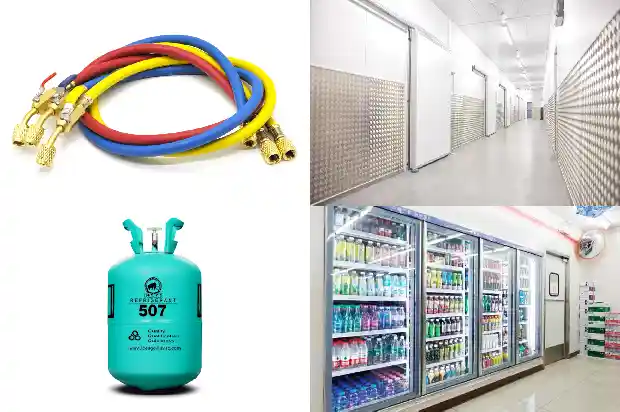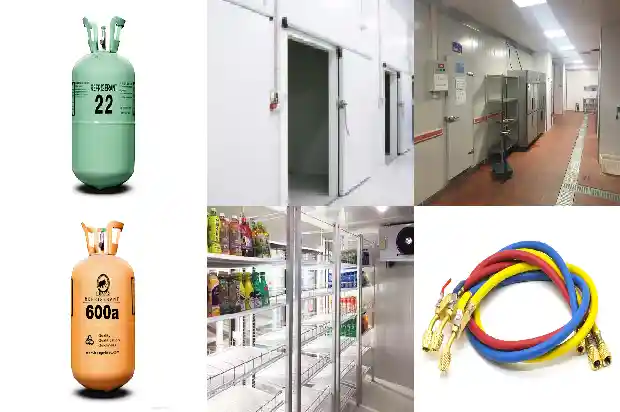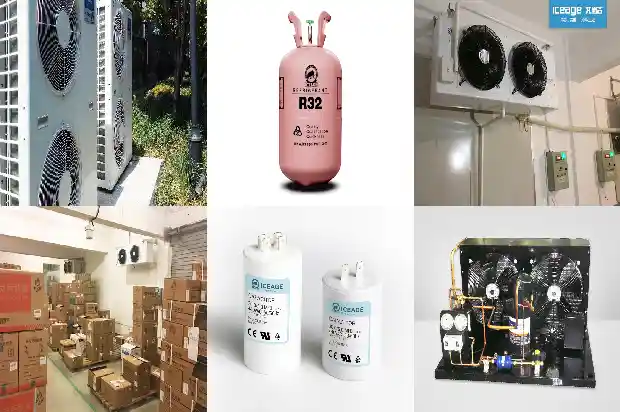Pressure Gauge in Refrigeration Equipment
2024-09-26
There are many types of pressure gauges, including general (ordinary) pointer indication type and digital type; there are conventional types and special types; there are contact type and remote transmission type; there are vibration-resistant type and seismic-resistant type; there are diaphragm type and corrosion-resistant type, etc. According to their installation structure types, they can be divided into direct installation type, inlay (panel-mounted) type and convex-mounted type. According to the installation method, they can be further divided into radial inlay and axial inlay. First of all, let's understand some terms and instruments related to general pressure gauges (pressure gauges take atmospheric pressure as the reference):
Pressure can be expressed in two ways: one is the pressure expressed with absolute vacuum as the reference, called absolute pressure; the other is the pressure expressed with atmospheric pressure as the reference, called relative pressure. Since most pressure measuring instruments measure relative pressure, relative pressure is also called gauge pressure. When the absolute pressure is less than atmospheric pressure, it can be expressed by the value that the absolute pressure in the container is less than one atmospheric pressure, which is called "vacuum degree".
Pressure can be expressed in two ways: one is the pressure expressed with absolute vacuum as the reference, called absolute pressure; the other is the pressure expressed with atmospheric pressure as the reference, called relative pressure. Since most pressure measuring instruments measure relative pressure, relative pressure is also called gauge pressure. When the absolute pressure is less than atmospheric pressure, it can be expressed by the value that the absolute pressure in the container is less than one atmospheric pressure, which is called "vacuum degree".
- Vacuum degree = atmospheric pressure - absolute pressure
- Absolute pressure = atmospheric pressure + relative pressure
- Positive pressure: Taking atmospheric pressure as the reference, pressure greater than atmospheric pressure. (The pressure gauge usually referred to is a positive pressure gauge.)
- Negative pressure: Taking atmospheric pressure as the reference, pressure less than atmospheric pressure. (A vacuum gauge is an instrument that takes atmospheric pressure as the reference and is used to measure negative pressure.)
- Differential pressure: The difference between two pressures. (A differential pressure gauge is an instrument used to measure the difference between two measured pressures.)
- Gauge pressure: Taking atmospheric pressure as the reference, pressure greater than or less than atmospheric pressure.

- Pressure vacuum gauge, also known as vacuum pressure gauge. It can measure not only positive pressure but also negative pressure.
The working principle of a pressure gauge is that the sensitive element (Bourdon tube, diaphragm box, bellows) inside the gauge undergoes elastic deformation after being subjected to pressure, and then the conversion mechanism inside the movement of the gauge conducts the deformation to the pointer, causing the pointer to rotate to display the pressure.
The specification models (nominal diameter of the casing) of pressure gauges include Φ40mm, Φ50mm, Φ60mm, Φ75mm, Φ100mm, Φ150mm, Φ200mm, Φ250mm, etc.
The precision grade classification of pressure gauges is very clear. Common precision grades include grade 4, grade 2.5, grade 1.6, grade 1, grade 0.4, grade 0.25, grade 0.16, grade 0.1, etc. The precision grade is generally marked on its dial, and there are corresponding regulations for its marking. For example, "①" indicates that its precision grade is grade 1. For some pressure gauges with very low precision grades, such as those below grade 4, and some that do not need to measure their accurate pressure values but only need to indicate the pressure range, such as the pressure gauge on a fire extinguisher, the precision grade may not be marked.
The measurement accuracy grades of general pressure gauges are 1.0, 1.6, 2.5, and 4.0 respectively.
On the units of refrigeration, refrigeration storage and air conditioning devices, in order to monitor the pressure of the refrigerant in the system, a special seismic-resistant pressure gauge for refrigeration will be installed. Since silicone oil is filled inside to prevent the pointer from vibrating, it is also called an oil-filled pressure gauge. In addition, when adding Freon to the system, a refrigeration pressure gauge will also be used to detect the pressure during filling. For ease of use, some oil-filled pressure gauges consist of multiple refrigerants in one gauge.
Refrigeration pressure gauges are generally divided into "high pressure gauge" and "low pressure gauge". Among them, the maximum reading of the "low pressure gauge" is generally 1.5MPa (some are 1.8MPa), and the maximum reading of the "high pressure gauge" is generally 3.5MPa (some are 3.
8MPa). Some oil-filled pressure gauges also display temperature values at the same time. Each circle is the condensing temperature corresponding to the pressure when different refrigerants are in operation. Precautions for selecting refrigeration pressure gauges:
- When choosing the usage range, according to the universality of load conditions, it is advisable to choose 1/3 to 2/3 of the full range, because this usage range has higher accuracy and can be used under both stable and fluctuating loads. The highest usage range shall not exceed 3/4 of the full scale of the dial.
- When in daily operation, equip a pressure gauge according to twice the actual working pressure. For example, if the working pressure is 0.2MPa, a pressure gauge with a range of 0.4MPa is used. In this way, the pointer is in the middle position of the dial and points vertically upward.
- When choosing, also consider the type of refrigerant, whether the applicable medium is liquid or gas, the temperature of the medium, pressure range, precision grade, protection grade, structure type, material of the instrument and surface, ambient temperature (minimum and maximum) for use, connection interface size, dial size, etc.
Precautions for installing refrigeration pressure gauges: - The pressure gauge should be calibrated by a pressure gauge calibration institution before installation. In principle, uncalibrated gauges are not allowed to be used.
- The installation position of the pressure gauge should meet the requirements of the installation state. The instrument must be placed vertically, and the height of the installation position should be convenient for the observation of staff.
When installing, use a wrench to tighten it. Do not forcibly twist the case. For a threaded pressure gauge, according to the operating conditions, Teflon tape can be wound 8 to 15 turns along the thread of the pressure gauge at the threaded connection to strengthen the sealing.
- The distance between the installation location of the pressure gauge and the pressure measurement point should be as short as possible. It is necessary to ensure complete sealing and there should be no leakage.
- For ease of inspection and replacement, a shut-off valve is generally installed under the instrument; when the medium is dirty or there is pulsed pressure, filters, buffers and pressure stabilizing gases can be used.
Daily use and maintenance of refrigeration pressure gauges: - Conduct inspection upon arrival. The pressure gauge should be accompanied by a certificate file, indicating the production time and number, precision grade, etc. Check the appearance of the pressure gauge. There should be no defects or scratches on the visible parts, no burrs or scratches on the joint threads. The graduated numbers and symbols on the pressure gauge dial should be complete and clear. The graduated scale on the dial should be evenly distributed, and the pointer should extend into all the graduation lines.
- Handle with care during storage, installation and transportation to avoid collisions.
- According to national regulations, the verification period of pressure gauges is half a year. They should be regularly sent to the legal metrology verification institution in the location for detection and verification. For those with large medium fluctuations at the pressure measurement part, frequent use, high accuracy requirements, and strict safety factor requirements, the verification period can be appropriately shortened according to specific circumstances. In particular, the periodic inspection period of the pressure gauge installed on the pressure vessel should be submitted for inspection in strict accordance with the period determined by the inspection institution according to the safety status level of the pressure vessel.
- Due to long-term use and being under pressure, the movement of the pressure gauge will inevitably have some deformation and wear, and the pressure gauge will produce various errors and malfunctions. In order to ensure accuracy and prevent distortion of quantity value transmission, it should be verified and replaced in time to ensure the correctness of the indication and the safety and reliability of the equipment.
Related Articles
- Winter Approaches: How to Solve the Low High - pressure Issue of Air - cooled Condensing Units?
- Common Pressure Valves and Protection Devices in Refrigeration Units
- How to Troubleshoot and Repair High - pressure Protection of Air - cooled Units?
- How to Read the High - and Low - Pressure Gauges of Refrigeration Air - conditioners?
- Air - conditioner Low - pressure Alarm? These Nine Common Causes
- Why Does the Evaporation Temperature of the Refrigeration System Drop Too Low? And Why is the Condensing Pressure Too High?
- What are the Cooling and Heating Pressures of an Air Conditioner? How to Calculate the Optimal Refrigerant Quantity?
- Common Causes and Analysis of High and Low Pressure Alarms
- Obscure Knowledge of Static Pressure, Dynamic Pressure, Latent Heat and Sensible Heat in the HVAC Industry
- Multi-split air conditioner: Nitrogen charging for welding, pressure maintaining, vacuuming and refrigerant charging
- What Causes Noise in Pressure Reducing Valves?
- Reasons and Solutions for High and Low Condensing Pressure in Air-cooled and Water-cooled Systems
- Principle of Multiple Storages in One Unit and Evaporation Pressure Regulation Methods
- Causes and Solutions for Elevated Pressure in Cold Storage
- Analysis and Treatment of Common Low-Pressure Faults in Chillers
- What are the effects of pressure and temperature on the refrigeration system of a cold storage?
- Analysis and Treatment of Common Low Pressure Faults in Chillers
- 7 Reasons for Low Air Pressure in Cold Water Unit
